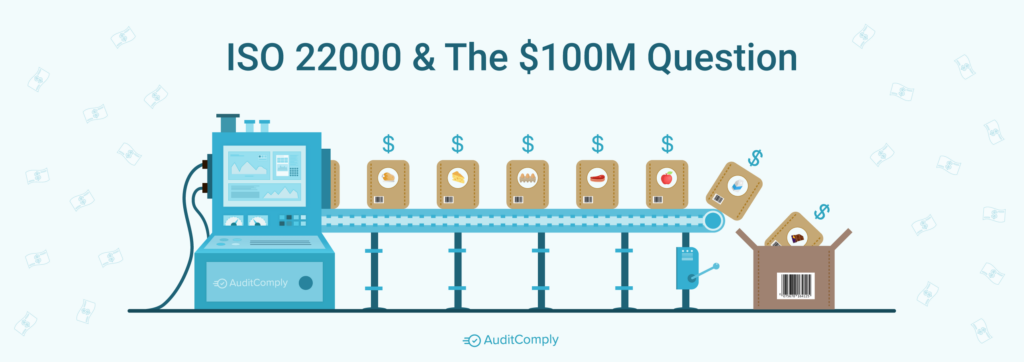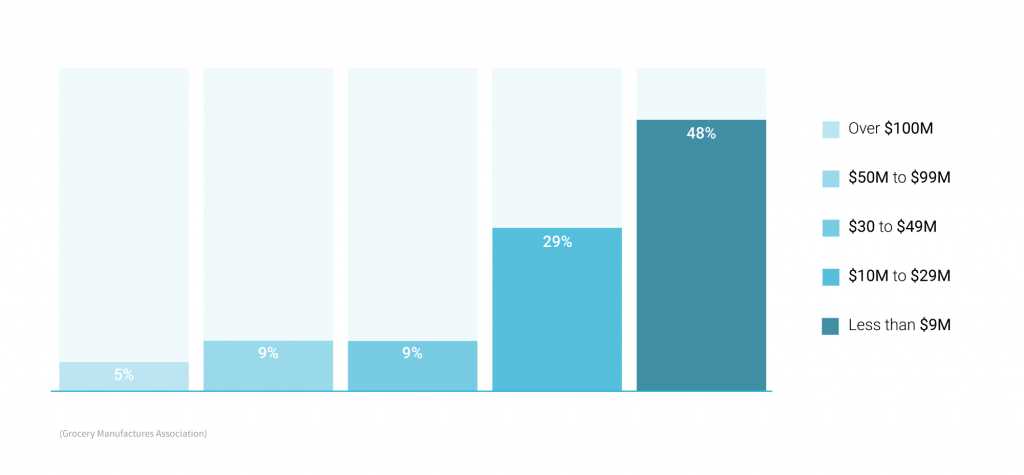
Recent years have provided us with strong evidence of the ever increasing demands for food safety. With supply chain shortcomings and threats to consumer’s health and safety being published across the media, the cost of poor food safety management is rising.
It’s not just consumers who are at risk. Food recalls cost companies an average of $10 million (per recall), in direct costs alone, according to a study by the Food Marketing Institute and the Grocery Manufacturers Association (GMA) in the US. A separate GMA sponsored survey found 5% of companies incurred over $100m in direct and indirect costs.
“What do you estimate the financial impact (sales losses, direct recall costs, etc.) to your company was as a result of the recall?”

These recurring problems and the need for consumer safety has increased the demand for additional tools to dramatically reduce or eliminate risks.
Introducing ISO 22000 & AuditComply:
ISO 22000 is part of the ISO (International Organization for Standardization) family and addresses food safety management.
ISO’s food safety management standards help organizations identify and control food safety hazards, eliminating risks across the food supply chain.
“As many of today’s food products repeatedly cross national boundaries, International Standards are needed to ensure the safety of the global food supply chain”. – ISO
The current ISO 22000, sets out the requirements for a food safety management system that can then be certified. It maps out what an organization needs to do to demonstrate its ability to control food safety hazards and thus ensure that food is safe. It can be used by any organization regardless of size or position in the food chain.
The standards are made up of these key parts:
-System Management
-Interactive Communication
-HACCP (Hazard Analysis and Critical Control Point) principles
-Prerequisite programs
For most organizations, ISO 22000 has meant:
-Ability to give their customers and stakeholders confidence (with the ISO 22000 certification) that the organization has the ability to control food safety hazards and complies with food safety practices.
-Ensure the ability to oversee all stages of the food supply chain, avoiding food safety hazards at each stage.
-Embed and improved the internal processes needed to provide consistently safe food.
-Provide continual improvement that ensures that the food safety management system is reviewed and updated so that all activities are continually optimized and effective.
-Provide confidence that the practices and procedures are in place and that they are effective and robust.
-Provides assurance about quality, safety and reliability for your consumers.
Everyone operating in the food industry should be aware of the advantages of implementing ISO 22000 within their organization. This certification provides companies with superior food safety and security, mitigates risk, improves quality and allows the operation of an efficient food supply chain. It is also possible to combine ISO 22000 with other management system standards, such as ISO 9001:2015, to maximize quality across the organization.
AuditComply can be used by organizations to facilitate their ISO compliance program. Users work with the AuditComply platform to generate bespoke audit templates to streamline and ensure adherence to their internal quality management system processes. To find out more about how AuditComply can help you achieve ISO 22000 compliance or avail of a free trial please contact us at info@auditcomply.com. The Leading Enterprise Risk Management Platform.
No matter the size or location of your organization, ISO 22000 is compatible. Through highlighting the benefits of the ISO 22000 certification and the risks associated with poor food supply chain practice, it’s difficult to understand why organizations would want to take the risk. Your organization will be able to deliver results and convey confidence across the board, impressing stakeholders and consumers with the ISO 22000 certificate.
The next update of the ISO food safety standards is expected to be published late in 2018.
For more information on ISO 22000 please click here.
For more information on ISO please click here.
Disclaimer: This blog is not legal advice and should be considered educational in nature.
